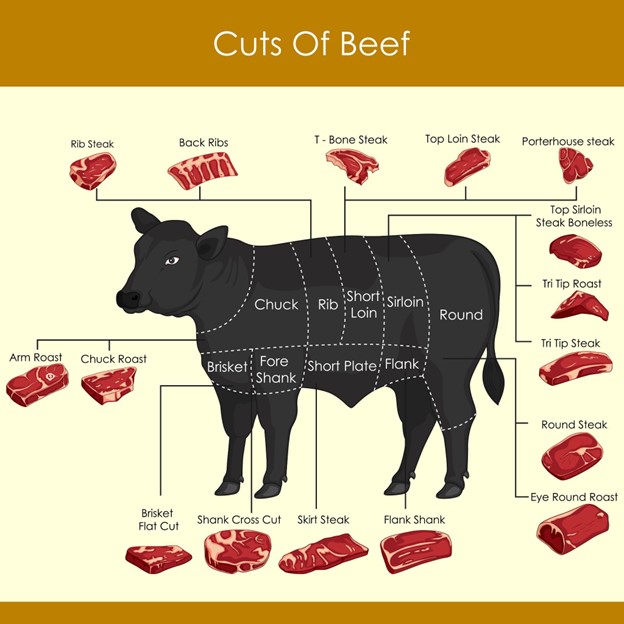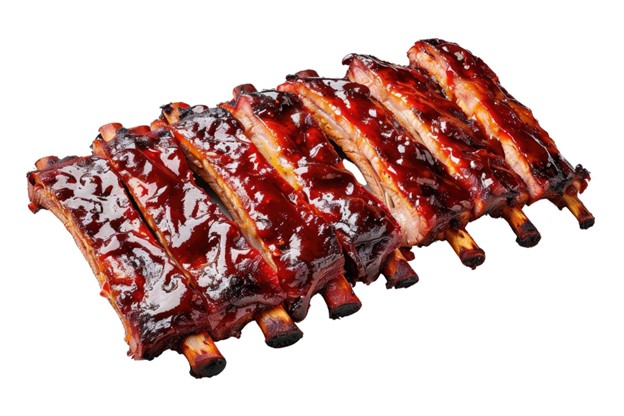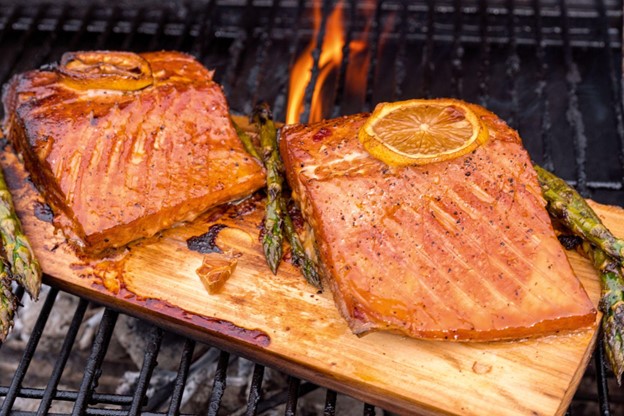Smoking allows meat to absorb flavour slowly without becoming too dehydrated. It tenderizes the food while adding a depth of flavour you can’t quite achieve from regular grilling.
The wood chip is a crucial aspect of savoury smoked meat. However, before you toss those beef and pork cuts to the smoker, you should know that certain cuts fare better than others when smoked.
Whether you consider yourself a seasoned barbecue enthusiast or simply one who enjoys backyard meals with your family, learning the best cuts of meat to smoke will transform your barbecue game.
Best Cuts of Beef For Smoking
The low and slow smoking process makes it a great tenderizer for all sorts of meat cuts, even the tough, sinewy parts. But when it comes to beef, picking the right cut to smoke is crucial to making your cookout a success.
Here’s a list of the best beef cuts to smoke, from beloved staples to underappreciated slices that make surprisingly savory bites.

1. Brisket
Brisket is one of the nine primal cuts of beef and is amongst the most favoured options for smoking. This meat slice comes from the cow’s pectoral muscles or breasts, just above its frontal legs.
The breast area typically produces chewy meat because it’s well-exercised and full of connective tissues. This quality makes brisket unsuitable for hot and quick cooking times.
When smoked, however, brisket is considered a top-tier beef cut and makes the most mouthwatering slice. Cooked slowly and well, brisket becomes a juicy and lusciously succulent delicacy!
An untrimmed cut is often cherished as the best brisket cut for smoking but it may make more sense to cook it in half.
There are two parts of a brisket: the flat and the point. A brisket flat or "first cut" is leaner while the point or "second cut" is fattier and well-marbled and the best brisket cut to buy for smoking if you’re a beginner.
For the best BBQ beef brisket, smoke the meat at around 225-250°F (107-121°C). When the brisket reaches 165°F (74°C), wrap it in foil and put it back to the smoker until you get an internal temperature of 203°F (95°C).
2. Beef Ribs
You might be used to grilling pork ribs at home. But if you have a smoker, smoking ribs is a must try.
Taken from the cow’s rib section, beef ribs transform into tender meat that drips with flavor when given the slow and thorough cooking treatment.
Well-marbled bone-in ribs are a popular choice for smoking—the fat lending a distinctive flavor while keeping the meat moist. It’s taken from the region between the cow’s flank meat and brisket.
Beef ribs can take a few trial and error to perfect. So, it may not be the best cut of meat to smoke for beginners.
Get your temperatures to reach between 225 and 250°F (107 to 121°C) to get the most smokey bite. To make the beef ribs tender and juicy on the insides, aim for a temperature of 195-203°F (91-95°C).
Smoking beef ribs can take 5 to 6 hours. Some recipes may recommend 8 to 10 hours, although it usually depends on the thickness of the meat.
3. Chuck Roast
The chuck roast comes from the cow’s upper shoulder and lower neck, right above the brisket. It’s usually leaner and tougher than ribs or brisket. Although, that also means it's more affordable in the market.
Cheaper doesn’t always mean less tasty, though. While it starts out tougher than most cuts, chuck roast produces some of the most intense and beefy flavors when smoked. Cooking time usually takes 5 to 6 hours.
To enjoy the most delectable smoked chuck roast, keep your smoker temperature between 225 and 250°F (107 to 121°C). Inside, aim for a temperature of 200 to 205°F (93 to 96°C).
Deep and rich, hickory is the best choice of wood chip to smoke chuck roast. It lends a potent and hearty flavor to the beef meat, with a smokiness that reminds you of bacon. It burns clean and long, too!

4. Tri-Tip
You can find the tri-tip at the bottom of the sirloin, easily identifiable for its distinctively triangular shape (hence, the name). It’s lean and smaller than most cust, but also tender and moist, perfect for the slow-cooking smoker.
The tri-tip or "California cut" is a versatile beef slice with plenty of uses in many recipes. It’s particularly popular on the West Coast, where the tri-tip roast was first popularized.
It is considered one of the best beef roast for smoker, finding its way into many barbecue aficionado's plates.
To smoke beef tri-tip, keep the temperature at around 225 to 250°F (107 to 121°C). Avoid overcooking by aiming the internal temperature at 140 to 145°F (60 to 63°C). Smoking a lean tri-tip only takes an hour or two.

5. Top Sirloin Steak
The sirloin is a large area between the cow’s 13th rib and hip bone and the backbone flowing down to the belly or flank. It’s usually divided and sold into two parts: the bottom and top sirloin. The top half is usually what’s made into steaks.
Since the sirloin is close to the mammal’s rear legs, the meat is often tougher and therefore ideal for grilling and smoking. Because it’s lean, it doesn’t require half a day inside the smoker to turn juicy and tasty.
A top sirloin is best marinated before smoked. To get that rich roast flavor with a steak-like texture, aim for a temperature between 225°F and 275°F (107°C to 135°C). For more even cooking, allow the meat to rest at room temperature for 30 minutes.
Besides hickory, mesquite chips are the best wood pairing for smoking top sirloin steak. This hardwood has a uniquely potent scent and lends a smoky yet slightly spicy flavor to the beef meat.
Other Best Meat Cuts For Smoking
Of course, the art of smoking goes way beyond beef. If you find yourself craving flavors other than brisket, try these meat cuts for your next cookout:
Pork Shoulder
If you want to try making pulled pork, the shoulder is the cut you’re looking for. It’s the part located just above the front legs, divided into two parts: the picnic shoulder and the pork butt.
A pork’s shoulder gets a lot of workouts. And that’s what you want when smoking any meat—the more connective tissue; the more collagen to break down.
Many prefer the pork butt typically because it has more fat and marbling. When smoked, this quality results in a lump of meat so juicy and tender you can pull it apart with a fork.

Spare Ribs
A pork’s spare ribs start from its lower rib cage and down to its belly. You can easily identify these rib cuts from their less pronounced curvature, owing to their proximity to the mammal’s stomach.
That said, because they’re close to the belly, spare ribs have plenty of tissues and fat. As it smokes slowly, the chewy meat softens, and the tissues turn into a melty goodness!
Lamb Breast
Lamb breast meat is a superb choice for anyone with little experience smoking lamb but doesn’t want to compromise taste. It’s incredibly fatty and loaded with many connective tissues, making it extra juicy and less prone to drying.
We suggest leaving the thick fat intact but trimming the rib flaps. You need it to keep the cut dripping with juice even if you happen to leave it too long in the smoker.
Salmon Filets
Salmon is a versatile fish meat with numerous ways to cook and enjoy. Smoking, however, takes salmon filets to the next level.
Hot-smoked salmon delivers a slice of silky and deliciously tender meat with a smokey exterior. Brined and cooked at around 225°F (107°C), it tastes phenomenal whether consumed on its own or stirred into scrambled eggs.
Why Choosing the Right Cut For Smoking Is Important
Choosing the right meat cuts is important because smoking involves cooking slowly and consistently at low heat. Generally, smoking takes about 30 minutes for every pound of meat but it can be longer, depending on the cut and thickness.
Good, lean meat won’t be able to handle the prolonged smoking process. They turn dry and chewy (worst case, inedible) after being exposed to heat for several hours. Tougher meat cuts, however, will come out tender and juicy, and more enjoyable to eat.
Final Thoughts
Meat cuts that are often considered low-quality turn into savory delicacies when smoked. Cuts that are brimming with fat and tissue become the most succulent bites when given careful and thorough attention.
Avoid wasting money and skip the tenderloin and the lean roasts the next time you’re shopping for your next barbeque night. Instead, stock on brisket, beef ribs, chuck roast, tri-tip, or top sirloin!

